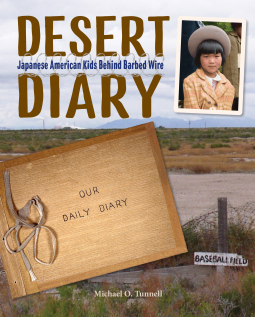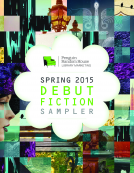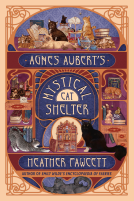
Desert Diary
Japanese American Kids Behind Barbed Wire
by Michael O. Tunnell
This title was previously available on NetGalley and is now archived.
Send NetGalley books directly to your Kindle or Kindle app
1
To read on a Kindle or Kindle app, please add kindle@netgalley.com as an approved email address to receive files in your Amazon account. Click here for step-by-step instructions.
2
Also find your Kindle email address within your Amazon account, and enter it here.
Pub Date Oct 06 2020 | Archive Date Oct 05 2020
Talking about this book? Use #DesertDiary #NetGalley. More hashtag tips!
Description
A classroom diary created by Japanese American children paints a vivid picture of daily life in a so-called "internment camp." Mae Yanagi was eight years old when she started school at Topaz Camp in Utah. She and her third-grade classmates began keeping an illustrated diary, full of details about schoolwork, sports, pets, holidays, and health--as experienced from behind barbed wire. Diary pages, archival photographs, and narrative nonfiction text convey the harsh changes experienced by the children, as well as their remarkable resilience.
Available Editions
| EDITION | Other Format |
| ISBN | 9781580897891 |
| PRICE | $19.99 (USD) |
| PAGES | 144 |
Average rating from 8 members
Featured Reviews
 Prism O, Educator
Prism O, Educator
Fascinating look at a daily school children’s diary of life in a Japanese internment camp in Utah. This is a quick read as the diary is short. Despite extreme limitations, these families made the most of their situation and survived and thrived under extenuating circumstances. They lost everything, - their land, businesses, former lives for the sake of political power, and still they blossomed in the dry and unforgiving desert. There were spaces for future photographs not included in this book; I’m sorry I wasn’t able to view but a few of them in the preview. Spot on take of a shameful chapter in American history. It’s a blessing this diary exists, as much of the history of these camps have either been downplayed or faded away. Book described as “Children’s Nonfiction” but appropriate for all ages. Highly recommend if you study American History. Will present much better once published with all photographs included.
Thank you to Netgalley and Charlesbridge publishers for an ARC in exchange for my honest opinion.
 Penny P, Librarian
Penny P, Librarian
Mae Yanagi was just seven years of age when her family was forcibly removed from their home in Hayward, CA to the Tanforan racetrack and then the Topaz center (which the author purposely avoids calling an internment camp). There, she and her classmates made a special scrapbook that is the basis of this history of the World War II Japanese American experience. Tunnell (The Children of Topaz, Holiday House, 1996) has written other books on this topic and this is equally well-researched; because it is told through the experience of children and young adults, included noted Berkeley author Yoshiko Uchida, it is especially compelling and relevant to Bay Area libraries. Color or b&w photos on nearly every page add interest and are well-captioned, helping those newer to this subject grasp the stark circumstances of this imprisonment. These include both general photos as well as reproductions of pages from the diary/scrapbook. Back matter includes source notes, bibliography, index, and other clarifying notes from the author and editor.
 Teresa B, Librarian
Teresa B, Librarian
Here's a good look at daily living, from a child's perspective, in a Japanese internment camp during WWII. Photos, personal anecdotes, and vivid descriptions bring the experience to life for young readers.
A beautiful book incorporating engaging visuals, primary source documents, and accounts of the lives of Japanese Americans interned at the Topaz incarceration camp during WWII. Prominent historical figures are mentioned throughout, such as Yoshiko Uchida, a prevalent writer of her first-hand accounts of internment. As a middle school ELA teacher, I seek resources that will help my visual learners and expand perspective of the issues we discuss. The incorporation of the childrens' perspectives, images, and anecdotes will make content more reachable for students to connect to and develop their sense of empathy. Thank you, Netgalley, for the ARC opportunity to examine and review this meaningful informational text.
 Vonda S, Reviewer
Vonda S, Reviewer
This true story is author, Michael Tunnell’s 2nd book about the people at Topaz Relocation Center. This book follows the experiences of the 3rd grade Japanese students in Miss Yamauchi’s class detained at Topaz near Delta, Utah. These kids and their families, most of whom were American citizens, were rounded up and sent as prisoners to Topaz shortly after the Japanese attacked Pearl Harbor. The impetus for the round up was fear that these Japanese Americans would somehow betray America in war.
The journal and drawings the class made detail their normal, everyday activities while experiencing an out of the ordinary, difficult situation. Most of their families lost their homes, businesses and belongings when relocated and were placed in poor living conditions. In spite of this abhorrent treatment, they were able to rise above and make the best of their situation. They talked about their pets, their festivals and holidays, their pranks, who was sick, the dry, windy weather, their friends and their parents.
I recommend this book for middle to upper elementary or even Junior High. Topics will be relevant and relatable to these age groups because a lot of the information shared is from kids’ perspectives.
I appreciate that reparations information was shared at the end. Several Presidents worked to recognize the wrongs done to the Japanese Americans during World War 2. I believe these topics are timely and would open a door for important discussions with kids. Many photos are included of the real journals, kids’ drawings and various life experiences they encountered.
I Received a digital ARC copy from the publisher via NetGalley in exchange for my honest opinion.
Desert Diary would be a fantastic addition to any middle school classroom. It follows the perspective of a young girl in a Japanese internment camp during WWII. It's evident that the author did a lot of research in preparation for this story. There are different sources and graphics available in the book to keep young readers attention on such a serious topic. Moreover, since it follows the story of someone closer to their age, it's much more effective than reading from a textbook. Well written, and informative!
Michael Tunnell discovered a diary in the Utah State Historical Society in Salt Lake City, kept by a third grade class in the Topaz Camp in Utah. This group of Japanese American children wrote and drew pictures of the happenings during that year in school in the internment camp during World War II. He has added well-researched narrative that brings their story together without intruding on their story in the book Desert Diary. The diary begins on March 8th and extends through August 12th with school extended through the summer because of the disruption the children have experienced. Both pictures and narrative of the children in the 72-page account give a first-person account of life in an internment camp.
These children have been moved from the luxuriant California area into the desert. Their pictured surroundings scorpions and little vegetation beyond greasewood bushes. Teacher Miss Yamauchi brings a sense of normality to eight-year-old Mae Yanagi and her classmates. Classroom pets included prairie dogs, horned toads, and ants! Even under these circumstances, the children participate in the junior Red Cross, promote war bond purchases, and grow Victory Gardens. The diary records a baseball game but doesn’t name the winner. The community joined to observe both Christian and Buddhist holidays and celebrations.
The children recorded happenings in the community – births, deaths, and marriages. The most significant one was Miss Yamauchi’s own! The children took a vote after the wedding about whether to continue to call her by the name they knew or to call her “Mrs. Hori.” They voted to continue to call her by her maiden name. The class’s reasonably normal schoolyear is a tribute to a creative teacher and to their own resilience.
The diary ends with the end of school, but the author adds some information in an epilogue about the return to “normal” and the aftereffects of the internment on its citizens when the camp years were ended. Interesting back matter includes a glossary, an editor’s note on terminology, photo credits, and information about the sources he used and the people he met as he put their stories together. The book is listed for fourth to seventh grade, but I think anyone with an interest in the history of World War II would find it fascinating.
This book takes entries from a classroom diary, that of Miss Yamauchi's 3rd grade class of 1942-1943 at the Topaz Camp in Utah, and creates a history book that becomes more relatable for children; it shows what Japanese children went through at the prison camps in the United States during World War II. I think it's good that children are being made aware of the terrible treatment of Japanese Americans at that time- when I was in grade school in the 1970's, I don't remember being taught this part of history in school, but it's important. Kids need to learn about the bad parts of our history in addition to the good, so that hopefully we don't repeat it in the future. This book is well researched, well illustrated, touching, and poignant, and includes a lot of end material to fill in more of the story, as well as give updates on some of the students who contributed to this book. A worthy addition to any library, public, school, classroom, or home.
#DesertDiary #NetGalley






